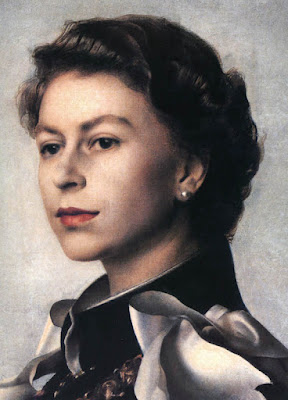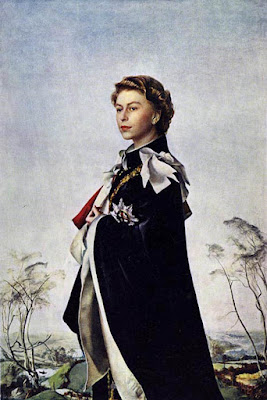Following up yesterday's post about Why Bother Copying a Photo?, it might be valuable to consider the views of Italian artist Pietro Annigoni (1910-1988). In a YouTube video in the Italian language, he discusses why he doesn't use photography in his work. Blog reader Mario Zara generously provided the following translation:
Interviewer: for example, you are one of the few painters, if not the only one, who doesn't use photography. Today everyone...
Answer: Well, this return to the so-called classicism, to reality, based on photography, in my opinion is a mistake, it's a form of impairment, in the end, because working from life, which is so transient, always changing, manifesting infinite aspects... working from life means that you accept an effort, a struggle, a labor of conquest, which is removed if you use photography. If you remove this big effort, this struggle, you are removing too much... too many important aspects of art
I: So it's easy to copy a photo..
A: Well... it definitely makes things easier. And then photography is a frozen instant of this reality, this truth I was talking about. Because truth changes together with us, while you are looking at it, it escapes, and you have to chase after it. It's a completely different view of life, I would say.
I: So, besides technique, there is also a psychological aspect.
A: Yes, of course, it's a different way of life.
I: So, the difficult part of portraiture - When you make a portrait, you require many sitting, don't you?
A: yes
I: What is the difficult part? In grasping the essence of the character?
A: To grasp something that is continuously escaping, in the end.
I: Which is the synthesis of that personality, because the instant...
A: The synthesis of...? It's the synthesis of I don't know what, it's that personality, and my personality mixed together. It's an experience of life, anyway... that's what, in my opinion, the use of photography cancels.
 I: So you start studying the character of the model by means of drawings? What do you do?
I: So you start studying the character of the model by means of drawings? What do you do?A: For me a portrait, or a figure, is first of all an object, like painting a still life. I have to draw this object, to put the eyes, the nose, the mouth and the ears in the right place... I mean, the construction of the figure, its shoulders and everything. Then, at a certain moment, I have to 'go inside' this human being.
So in the first poses I ask for a complete silence and stillness, then, after blocking in the portrait, as I said, with a construction as correct as possible, I start to talk to the person about many subjects, about any subject, in order to see how he or she reacts, and lives, and so on, and I myself identify with that person on those subjects. It is a way to go inside that person, also psychologically.
I: It's...
A: A long, hard, laboring work. That's why, at a certain point, I got tired of making portraits...
I: But the most difficult thing is to let the soul come out from the eyes, isn't it?A: Well, yes, from the eyes, and from every part: from everything. Sometimes it's a matter of an instant, of a glimmer on a certain part of the face, which can change the expression. There are many aspects...
I: So during many sittings... there comes a moment... when everything gets becomes clear and illuminated...
A: Well, there is... when there is... but sometimes there isn't, and you have to adapt.
I: I've read in your diary, when you went to the US, that J.F. Kennedy let you in his office when he was meeting with his staff.
A: That was the kind of portrait I did for the Time Magazine covers. A few of these things were unfortunately disastrous for me.
I: It's...
A: A long, hard, laboring work. That's why, at a certain point, I got tired of making portraits...
I: But the most difficult thing is to let the soul come out from the eyes, isn't it?A: Well, yes, from the eyes, and from every part: from everything. Sometimes it's a matter of an instant, of a glimmer on a certain part of the face, which can change the expression. There are many aspects...
I: So during many sittings... there comes a moment... when everything gets becomes clear and illuminated...
A: Well, there is... when there is... but sometimes there isn't, and you have to adapt.
I: I've read in your diary, when you went to the US, that J.F. Kennedy let you in his office when he was meeting with his staff.
A: That was the kind of portrait I did for the Time Magazine covers. A few of these things were unfortunately disastrous for me.

I: They considered you the painter, and let you stay near him?
A: He didn't pose, I was forced to “steal”...
I: Which models were the most patient? Was it the Queen of England, or the Pope?
A: Oh, well, those... No. The Pope was like Kennedy. But the Queen at least granted me sixteen poses, Princess Margaret twenty-six. I've always tried to get as many poses as possible, because my type of art...
I: At least, on this subject, regarding you as a portrait-painter, no one has any grounds for objection, and they all agree...
A: Well, I don't know, they may take issue with that too, I don't know...
I: No, no, I say, it's unquestioned... at least on this subject, Annigoni...
A: yes, yes, they let me do portraits, because incidentally portraiture...
I: ..Is considered a genre...
A: A cheap genre, an outdated genre...
I: But on the contrary, it's the genre which requires the best technique and “eye”
A: Well, portraiture... is a big hassle...
I: So, you feel you really belong to our time, as a painter?
A: I feel... to our time? I don't know... to my time, that's for sure. If my time doesn't belong to our time, that's not my fault...
--
I: So, you feel you really belong to our time, as a painter?
A: I feel... to our time? I don't know... to my time, that's for sure. If my time doesn't belong to our time, that's not my fault...
--
Related previous posts:
Menzel and Photography


تعليقات
إرسال تعليق